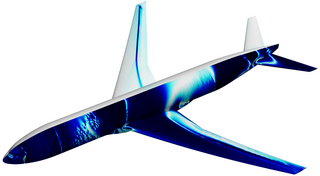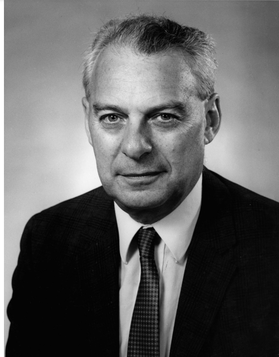Related Research Articles

In fluid dynamics, laminar flow is characterized by fluid particles following smooth paths in layers, with each layer moving smoothly past the adjacent layers with little or no mixing. At low velocities, the fluid tends to flow without lateral mixing, and adjacent layers slide past one another like playing cards. There are no cross-currents perpendicular to the direction of flow, nor eddies or swirls of fluids. In laminar flow, the motion of the particles of the fluid is very orderly with particles close to a solid surface moving in straight lines parallel to that surface. Laminar flow is a flow regime characterized by high momentum diffusion and low momentum convection.
In fluid dynamics, turbulence or turbulent flow is fluid motion characterized by chaotic changes in pressure and flow velocity. It is in contrast to a laminar flow, which occurs when a fluid flows in parallel layers, with no disruption between those layers.
Quantum turbulence is the name given to the turbulent flow – the chaotic motion of a fluid at high flow rates – of quantum fluids, such as superfluids. The idea that a form of turbulence might be possible in a superfluid via the quantized vortex lines was first suggested by Richard Feynman. The dynamics of quantum fluids are governed by quantum mechanics, rather than classical physics which govern classical (ordinary) fluids. Some examples of quantum fluids include superfluid helium, Bose–Einstein condensates (BECs), polariton condensates, and nuclear pasta theorized to exist inside neutron stars. Quantum fluids exist at temperatures below the critical temperature at which Bose-Einstein condensation takes place.

In theoretical physics, the (one-dimensional) nonlinear Schrödinger equation (NLSE) is a nonlinear variation of the Schrödinger equation. It is a classical field equation whose principal applications are to the propagation of light in nonlinear optical fibers and planar waveguides and to Bose–Einstein condensates confined to highly anisotropic, cigar-shaped traps, in the mean-field regime. Additionally, the equation appears in the studies of small-amplitude gravity waves on the surface of deep inviscid (zero-viscosity) water; the Langmuir waves in hot plasmas; the propagation of plane-diffracted wave beams in the focusing regions of the ionosphere; the propagation of Davydov's alpha-helix solitons, which are responsible for energy transport along molecular chains; and many others. More generally, the NLSE appears as one of universal equations that describe the evolution of slowly varying packets of quasi-monochromatic waves in weakly nonlinear media that have dispersion. Unlike the linear Schrödinger equation, the NLSE never describes the time evolution of a quantum state. The 1D NLSE is an example of an integrable model.

In fluid dynamics, the Taylor–Couette flow consists of a viscous fluid confined in the gap between two rotating cylinders. For low angular velocities, measured by the Reynolds number Re, the flow is steady and purely azimuthal. This basic state is known as circular Couette flow, after Maurice Marie Alfred Couette, who used this experimental device as a means to measure viscosity. Sir Geoffrey Ingram Taylor investigated the stability of Couette flow in a ground-breaking paper. Taylor's paper became a cornerstone in the development of hydrodynamic stability theory and demonstrated that the no-slip condition, which was in dispute by the scientific community at the time, was the correct boundary condition for viscous flows at a solid boundary.

In fluid dynamics, turbulence modeling is the construction and use of a mathematical model to predict the effects of turbulence. Turbulent flows are commonplace in most real-life scenarios, including the flow of blood through the cardiovascular system, the airflow over an aircraft wing, the re-entry of space vehicles, besides others. In spite of decades of research, there is no analytical theory to predict the evolution of these turbulent flows. The equations governing turbulent flows can only be solved directly for simple cases of flow. For most real-life turbulent flows, CFD simulations use turbulent models to predict the evolution of turbulence. These turbulence models are simplified constitutive equations that predict the statistical evolution of turbulent flows.

In fluid dynamics, an eddy is the swirling of a fluid and the reverse current created when the fluid is in a turbulent flow regime. The moving fluid creates a space devoid of downstream-flowing fluid on the downstream side of the object. Fluid behind the obstacle flows into the void creating a swirl of fluid on each edge of the obstacle, followed by a short reverse flow of fluid behind the obstacle flowing upstream, toward the back of the obstacle. This phenomenon is naturally observed behind large emergent rocks in swift-flowing rivers.

In dynamical systems, intermittency is the irregular alternation of phases of apparently periodic and chaotic dynamics, or different forms of chaotic dynamics.

In fluid dynamics, the law of the wall states that the average velocity of a turbulent flow at a certain point is proportional to the logarithm of the distance from that point to the "wall", or the boundary of the fluid region. This law of the wall was first published in 1930 by Hungarian-American mathematician, aerospace engineer, and physicist Theodore von Kármán. It is only technically applicable to parts of the flow that are close to the wall, though it is a good approximation for the entire velocity profile of natural streams.
Harry L. Swinney is an American physicist noted for his contributions to the field of nonlinear dynamics.
The Orr–Sommerfeld equation, in fluid dynamics, is an eigenvalue equation describing the linear two-dimensional modes of disturbance to a viscous parallel flow. The solution to the Navier–Stokes equations for a parallel, laminar flow can become unstable if certain conditions on the flow are satisfied, and the Orr–Sommerfeld equation determines precisely what the conditions for hydrodynamic stability are.
In continuum mechanics, wave turbulence is a set of nonlinear waves deviated far from thermal equilibrium. Such a state is usually accompanied by dissipation. It is either decaying turbulence or requires an external source of energy to sustain it. Examples are waves on a fluid surface excited by winds or ships, and waves in plasma excited by electromagnetic waves etc.
Robert Harry Kraichnan, a resident of Santa Fe, New Mexico, was an American theoretical physicist best known for his work on the theory of fluid turbulence.
In fluid mechanics, pipe flow is a type of liquid flow within a closed conduit, such as a pipe or tube. The other type of flow within a conduit is open channel flow. These two types of flow are similar in many ways, but differ in one important aspect. Pipe flow does not have a free surface which is found in open-channel flow. Pipe flow, being confined within closed conduit, does not exert direct atmospheric pressure, but does exert hydraulic pressure on the conduit.

Philip Geoffrey Saffman FRS was a mathematician and the Theodore von Kármán Professor of Applied Mathematics and Aeronautics at the California Institute of Technology.
Leslie S. G. Kovasznay was a Hungarian-American engineer, known as one of the world's leading experts in turbulent flow research.
Patrick Henry Diamond is an American theoretical plasma physicist. He is currently a professor at the University of California, San Diego, and a director of the Fusion Theory Institute at the National Fusion Research Institute in Daejeon, South Korea, where the KSTAR Tokamak is operated.
Robert Everett Ecke is an American experimental physicist who is a laboratory fellow and director emeritus of the Center for Nonlinear Studies (CNLS) at Los Alamos National Laboratory and Affiliate Professor of Physics at the University of Washington. His research has included chaotic nonlinear dynamics, pattern formation, rotating Rayleigh-Bénard convection, two-dimensional turbulence, granular materials, and stratified flows. He is a Fellow of the American Physical Society (APS) and of the American Association for the Advancement of Science (AAAS), was chair of the APS Topical Group on Statistical and Nonlinear Physics, served in numerous roles in the APS Division of Fluid Dynamics, and was the Secretary of the Physics Section of the AAAS.
Quantum turbulence involves the chaotic dynamics of many interacting quantum vortices. In highly excited bulk superfluid, many vortex lines interact with each other forming quantum turbulent states. By introducing tight confinement along one direction the Kelvin wave excitations can be strongly suppressed, favouring vortex alignment with the axis of tight confinement. Vortex dynamics enters a regime of effective 2D motion, equivalent to point vortices moving on a plane. In general, 2D quantum turbulence (2DQT) can exhibit complex phenomenology involving coupled vortices and sound in compressible superfluids. The quantum vortex dynamics can exhibit signatures of turbulence including a Kolmogorov −5/3 power law, a quantum manifestation of the inertial transport of energy to large scales observed in classical fluids, known as an inverse energy cascade.
Dominique Franck Escande is a French physicist. He is known for his research in plasma physics, thermonuclear fusion by magnetic confinement, hybrid fusion-fission reactors, Hamiltonian dynamics, and deterministic chaos.
References
- ↑ Barkley, Dwight. (September 2019). Curriculum vitae. University of Warwick.
- ↑ "Home page for Dwight Barkley". 4 October 2011. Retrieved 16 September 2015.
- ↑ "Dwight Barkley". scholar.google.com. Retrieved 14 September 2023.
- 1 2 3 "Dwight Barkley - ORCID". Orcid. Retrieved 14 September 2023.
- ↑ Barkley, Dwight (1991). "A model for fast computer simulation of waves in excitable media". Physica D: Nonlinear Phenomena. 49 (1–2): 61–70. Bibcode:1991PhyD...49...61B. doi:10.1016/0167-2789(91)90194-E.
- ↑ Barkley, Dwight (2008). "Barkley model". Scholarpedia. 3 (11): 1877. Bibcode:2008SchpJ...3.1877B. doi: 10.4249/scholarpedia.1877 .
- ↑ Barkley, Dwight (1994). "Euclidean symmetry and the dynamics of rotating spiral waves". Physical Review Letters. 72 (1): 164–167. Bibcode:1994PhRvL..72..164B. doi:10.1103/PhysRevLett.72.164. PMID 10055592.
- ↑ Tuckerman, Laurette S.; Barkley, Dwight (1998). "Bifurcation analysis for timesteppers". University of Minnesota digital conservancy. Retrieved 16 September 2015.
- ↑ Barkley, Dwight; Henderson, Ronald D. (2006). "Three-dimensional Floquet stability analysis of the wake of a circular cylinder". Journal of Fluid Mechanics. 322 (1): 215–241. Bibcode:1996JFM...322..215B. doi:10.1017/S0022112096002777. S2CID 53610776.
- ↑ Barkley, Dwight; Gomes, M. Gabriela M.; Henderson, Ronald D. (2002). "Three-dimensional instability in flow over a backward-facing step" (PDF). Journal of Fluid Mechanics. 473 (1): 167–190. Bibcode:2002JFM...473..167B. doi:10.1017/S002211200200232X. S2CID 54012009.
- ↑ Barkley, Dwight; Tuckerman, Laurette S. (2005). "Computational Study of Turbulent Laminar Patterns in Couette Flow". Physical Review Letters. 94 (1): 014502. arXiv: physics/0403142 . Bibcode:2005PhRvL..94a4502B. doi:10.1103/PhysRevLett.94.014502. PMID 15698087. S2CID 40340539.
- ↑ Tuckerman, Laurette S.; Chantry, Matthew; Barkley, Dwight (2020). "The Patterns in Wall-Bounded Shear Flows" (PDF). Annual Review of Fluid Mechanics. 52: 343–367. Bibcode:2020AnRFM..52..343T. doi:10.1146/annurev-fluid-010719-060221. S2CID 202155000.
- ↑ Avila, K.; Moxey, D.; de Lozar, A.; Avila, M.; Barkley, D.; Hof, B. (2011). "The Onset of Turbulence in Pipe Flow". Science. 333 (6039): 192–196. Bibcode:2011Sci...333..192A. doi:10.1126/science.1203223. PMID 21737736. S2CID 22560587.
- ↑ Avila, Marc; Barkley, Dwight; Hof, Bjorn (2023). "Transition to Turbulence in Pipe Flow" (PDF). Annual Review of Fluid Mechanics. 55: 575–602. Bibcode:2023AnRFM..55..575A. doi:10.1146/annurev-fluid-120720-025957.
- ↑ Barkley, Dwight (2011). "Simplifying the complexity of pipe flow". Physical Review E. 84 (1 Pt 2): 016309. arXiv: 1101.4125 . Bibcode:2011PhRvE..84a6309B. doi:10.1103/PhysRevE.84.016309. PMID 21867306. S2CID 16527841.
- ↑ Barkley, Dwight (2016). "Theoretical perspective on the route to turbulence in a pipe" (PDF). Journal of Fluid Mechanics. 803: P1. Bibcode:2016JFM...803P...1B. doi:10.1017/jfm.2016.465. S2CID 123707242.
- ↑ "Kids' car question put in formula", BBC News , 20 July 2006
- ↑ "J.D. Crawford Prize". SIAM . Retrieved 20 May 2015.
- ↑ "UK Nonlinear News Issue 40". www1.maths.leeds.ac.uk. Retrieved 14 September 2023.
- ↑ "Home - Unit - DFD" (PDF).
- ↑ "News 2010". warwick.ac.uk. Retrieved 14 September 2023.
- ↑ "Fellows Program | SIAM". www.siam.org. Retrieved 14 September 2023.